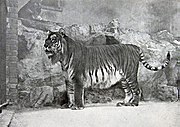The tiger (Panthera tigris) is a member of the Felidae family; the largest and strongest of the four "big cats" in the genus Panthera. Native to much of eastern and southern Asia, the tiger is an apex predator and an obligate carnivore. Reaching up to 4 metres (13 ft) in total length and weighing up to 300 kilograms (660 pounds), the larger tiger subspecies are comparable in size to the biggest extinct felids. Aside from their great bulk and power, their most recognizable feature is the pattern of dark vertical stripes that overlays near-white to reddish-orange fur, with lighter underparts. The largest subspecies of tiger is the Siberian tiger. The word "tiger" is taken from the Greek word "tigris", which is possibly derived from a Persian source meaning "arrow", a reference to the animal's speed and also the origin for the name of the River Tigris. In American English, "Tigress" was first recorded in 1611. It was one of the many species originally described, as Felis tigris, by Linnaeus in his 18th century work, Systema Naturae. The generic component of its scientific designation, Panthera tigris, is often presumed to derive from Greek pan- ("all") and theron ("beast"), but this may be a folk etymology. Although it came into English through the classical languages, panthera is probably of East Asian origin, meaning "the yellowish animal," or "whitish-yellow". A group of tigers is rare (see below), but when seen together is termed a 'streak' or an 'ambush'. In the historical past tigers were widespread in Asia, from the Caucasus and the Caspian Sea, to Siberia and Indonesia. During the 19th century the striped cats completely vanished from western Asia, and became restricted to isolated pockets in the remaining parts of their range. Today, this fragmented relic range extends from India in the west to China and Southeast Asia in the east. The northern limit is close to the Amur River in south eastern Siberia. The only large island inhabited by tigers today is Sumatra. Tigers vanished from Java during the second half of the 19th century, and in Borneo are known only from fossil remains. The oldest remains of a tiger-like cat, called Panthera palaeosinensis, have been found in China and Java. This species lived about 2 million years ago, at the beginning of the Pleistocene, and was smaller than a modern tiger. The earliest fossils of true tigers are known from Java, and are between 1.6 and 1.8 million years old. Distinct fossils from the early and middle Pleistocene were also discovered in deposits from China, and Sumatra. A subspecies called the Trinil tiger (Panthera tigris trinilensis) lived about 1.2 million years ago and is known fossils found at Trinil in Java. Tigers first reached India and northern Asia in the late Pleistocene, reaching eastern Beringia (but not the American Continent), and Japan, and Sakhalin. Fossils found in Japan indicate that the local tigers were, like the surviving island subspecies, smaller than the mainland forms. This may be due to the phenomenon in which body size is related to environmental space (see insular dwarfism), or perhaps the availability of prey. Until the Holocene, tigers also lived in Borneo. Today, tigers are perhaps the most recognisable of all the cats (with the possible exception of the lion). They typically have rusty-reddish to brown-rusty coats, a whitish medial and ventral area, a white "fringe" that surrounds the face, and stripes that vary from brown or gray to pure black. The form and density of stripes differs between subspecies (as well as the ground coloration of the fur; for instance, Siberian tigers are usually paler than other tiger subspecies), but most tigers have over 100 stripes. The pattern of stripes is unique to each animal, and thus could potentially be used to identify individuals, much in the same way as fingerprints are used to identify people. This is not, however, a preferred method of identification, due to the difficulty of recording the stripe pattern of a wild tiger. It seems likely that the function of stripes is camouflage, serving to help tigers conceal themselves amongst the dappled shadows and long grass of their environment as they stalk their prey. The stripe pattern is found on a tiger's skin and if shaved, its distinctive camouflage pattern would be preserved. Like other big cats, tigers have a white spot on the backs of their ears. Tigers have the additional distinction of being the heaviest cats found in the wild. However, the subspecies differ markedly in size, tending to increase proportionally with latitude, as predicted by Bergmann's Rule. Thus, large male Siberian Tigers (Panthera tigris altaica) can reach a total length of 3.5 m and a weight of 306 kilograms, which is considerably larger than the sizes reached by island-dwelling tigers such as the Sumatran, the smallest living subspecies with a body weight of only 75-140 kg. Tigresses are smaller than the males in each subspecies, although the size difference between male and female tigers tends to be more pronounced in the larger subspecies of tiger, with males weighing up to 1.7 times as much as the females. In addition, male tigers have wider forepaw pads than females. This difference is often used by biologists in determining the gender of tigers when observing their tracks. There are nine recent subspecies of tiger, three of which are extinct. Their historical range (severely diminished today) ran through Bangladesh, Siberia, Iran, Afghanistan, India, China, and southeast Asia, including some Indonesian islands. The surviving subspecies, in descending order of wild population, are: Hybridization among the big cats, including the tiger, was first conceptualized in the 19th century, when zoos were particularly interested in the pursuit of finding oddities to display for financial gain. Lions have been known to breed with tigers (most often the Amur and Bengal subspecies) to create hybrids called ligers and tigons. Such hybrids were once commonly bred in zoos, but this is now discouraged due to the emphasis on conserving species and subspecies. Hybrids are still bred in private menageries and in zoos in China. The liger is a cross between a male lion and a tigress.Because the lion sire passes on a growth-promoting gene, but the corresponding growth-inhibiting gene from the female tiger is absent, ligers grow far larger than either parent. They share physical and behavioural qualities of both parent species (spots and stripes on a sandy background). Male ligers are sterile, but female ligers are often fertile. Males have about a 50% chance of having a mane, but, even if they do, their manes will be only around half the size of that of a pure lion. Ligers are typically between 10 to 12 feet in length, and can be between 800 and 1,000 pounds or more. The less common tigon is a cross between the lioness and the male tiger. There is a well-known mutation that produces the white tiger, technically known as chinchilla albinistic, an animal which is rare in the wild, but widely bred in zoos due to its popularity. Breeding of white tigers will often lead to inbreeding (as the trait is recessive). Many initiatives have taken place in white and orange tiger mating in an attempt to remedy the issue, often mixing subspecies in the process. Such inbreeding has led to white tigers having a greater likelihood of being born with physical defects, such as cleft palates and scoliosis (curvature of the spine). Furthermore, white tigers are prone to having crossed eyes (a condition known as strabismus). Even apparently healthy white tigers generally do not live as long as their orange counterparts. Recordings of white tigers were first made in the early 19th century. They can only occur when both parents carry the rare gene found in white tigers; this gene has been calculated to occur in only one in every 10,000 births. The white tiger is not a separate sub-species, but only a colour variation; since the only white tigers that have been observed in the wild have been Bengal tigers (and all white tigers in captivity are at least part Bengal), it is commonly thought that the recessive gene that causes the white colouring is probably carried only by Bengal tigers, although the reasons for this are not known. Nor are they in any way more endangered than tigers are generally, this being a common misconception. Another misconception is that white tigers are albinos, despite the fact that pigment is evident in the white tiger's stripes. They are distinct not only because of their white hue; they also have blue eyes and pink noses. In addition, another recessive gene may create a very unusual "golden tabby" colour variation, sometimes known as "strawberry". Golden tabby tigers have light gold fur, pale legs and faint orange stripes. Their fur tends to be much thicker than normal. There are extremely few golden tabby tigers in captivity, around 30 in all. Like white tigers, strawberry tigers are invariably at least part Bengal. Both white and golden tabby tigers tend to be larger than average Bengal tigers. There are also unconfirmed reports of a "blue" or slate-coloured tiger, and largely or totally black tigers, and these are assumed, if real, to be intermittent mutations rather than distinct species. Tigers are essentially solitary and territorial animals. The size of a tiger's home range mainly depends on prey abundance, and, in the case of male tigers, on access to females. A tigress may have a territory of 20 square kilometres while the territories of males are much larger, covering 60–100 km². The ranges of males tend to overlap those of several females. The relationships between individuals can be quite complex, and it appears that there is no set "rule" that tigers follow with regards to territorial rights and infringing territories. For instance, although for the most part tigers avoid each other, both male and female tigers have been documented sharing kills. For instance, George Schaller observed a male tiger share a kill with two females and four cubs. Females are often reluctant to let males near their cubs, but Schaller saw that these females made no effort to protect or keep their cubs from the male, suggesting that the male might have been the father of the cubs. In contrast to male lions, male tigers will allow the females and cubs to feed on the kill first. Furthermore, tigers seem to behave relatively amicably when sharing kills, in contrast to lions, which tend to squabble and fight. Unrelated tigers have also been observed feeding on prey together. The following quotation is from Stephen Mills' book Tiger, as he describes an event witnessed by Valmik Thapar and Fateh Singh Rathore in Ranthambhore: A dominant tigress they called Padmini killed a 250-kg (550-lb) male nilgai - a very large antelope. They found her at the kill just after dawn with her three 14-month-old cubs and they watched uninterrupted for the next ten hours. During this period the family was joined by two adult females and one adult male - all offspring from Padmini's previous litters and by two unrelated tigers, one female the other unidentified. By three o'clock there were no fewer than nine tigers round the kill. When young female tigers first establish a territory, they tend to do so fairly close to their mother's area. The overlap between the female and her mother's territory tends to wane with increasing time. Males, however, wander further than their female counterparts, and set out at a younger age to eke out their own area. A young male will acquire territory either by seeking out a range devoid of other male tigers, or by living as a transient in another male's territory, until he is old and strong enough to challenge the resident male. The highest mortality rate (30-35% per year) amongst adult tigers occurs for young male tigers who have just left their natal area, seeking out territories of their own. Male tigers are generally more intolerant of other males within their territory than females are of other females. For the most part, however, territorial disputes are usually solved by displays of intimidation, rather than outright aggression. Several such incidents have been observed, in which the subordinate tiger yielded defeat by rolling onto its back, showing its belly in a submissive posture. Once dominance has been established, a male may actually tolerate a subordinate within his range, as long as they do not live in too close quarters. The most violent disputes tend to occur between two males when a female is in oestrus, and may result in the death of one of the males, although this is actually a relatively rare occurrence. To identify his territory, the male marks trees by spraying of urine and anal gland secretions, as well as marking trails with scat. Males show a grimacing face, called the Flehmen response, when identifying a female's reproductive condition by sniffing their urine markings. Tigers have been studied in the wild using a variety of techniques. The populations of tigers were estimated in the past using plaster casts of their pugmarks. This method was found faulty and attempts were made to use camera trapping instead. Newer techniques based on DNA from their scat are also being evaluated. Radio collaring has also been a popular approach to tracking them for study in the wild. In the wild, tigers mostly feed on larger and medium sized animals. Sambar, gaur, domestic buffalo, chital, boar, and nilgai are the tiger's favored prey in India. Sometimes, they also prey on leopards, pythons, sloth bears and crocodiles. In Siberia the main prey species are Mandchurian elk, wild boar, Sika Deer, Moose, roe deer, and musk deer. In Sumatra Sambar, Muntjac, wild boar, and Malayan Tapir are preyed on. In the former Caspian tiger's range, prey included Saiga Antelope, camels, Caucasian Wisent, yak, and wild horses. Like many predators, they are opportunistic and will eat much smaller prey, such as monkeys, peafowls, hares, and fish. Adult elephants are too large to serve as common prey, but conflicts between tigers and elephants do sometimes take place. A case where a tiger killed an adult Indian Rhinoceros has been observed. Young elephant and rhino calves are occasionally taken. Tigers also sometimes prey on domestic animals such as dogs, cows, horses, and donkeys. These individuals are termed cattle-lifters or cattle-killers in contrast to typical game-killers. Old tigers, or those wounded and rendered incapable of catching their natural prey, have turned into man-eaters; this pattern has recurred frequently across India. An exceptional case is that of the Sundarbans, where healthy tigers prey upon fishermen and villagers in search of forest produce, humans thereby forming a minor part of the tiger's diet. Tigers will occasionally eat vegetation for dietary fiber, the fruit of the Slow Match Tree being favoured. Tigers usually hunt at night. They generally hunt alone and ambush their prey as most other cats do, overpowering them from any angle, using their body size and strength to knock large prey off balance. Even with their great masses, tigers can reach speeds of about 49-65 kilometres per hour (35-40 miles per hour), although they can only do so in short bursts, since they have relatively little stamina; consequently, tigers must be relatively close to their prey before they break their cover. Tigers have great leaping ability; horizontal leaps of up to 10 metres have been reported, although leaps of around half this amount are more typical. However, only one in twenty hunts ends in a successful kill. When hunting large prey, tigers prefer to bite the throat and use their forelimbs to hold onto the prey, bringing it to the ground. The tiger remains latched onto the neck until its prey dies of strangulation. By this method, gaurs and water buffalos weighing over a ton have been killed by tigers weighing about a sixth as much. With small prey, the tiger bites the nape, often breaking the spinal cord, piercing the windpipe, or severing the jugular vein or common carotid artery. Though rarely observed, some tigers have been recorded to kill prey by swiping with their paws, which are powerful enough to smash the skulls of domestic cattle, and break the backs of sloth bears. During the 1980s, a tiger named "Genghis" in Ranthambhore National Park was observed frequently hunting prey through deep water at the edges of lakes, a pattern of behaviour that had not been previously witnessed in over 200 years of observations. Moreover, he appeared to be extraordinarily successful for a tiger, with as many as 20% of hunts ending in a kill. Mating can occur all year round, but is generally more common between November and April. A female is only receptive for a few days and mating is frequent during that time period. A pair will copulate frequently and noisily, like other cats. The gestation period is 16 weeks. The litter size usually consists of around 3–4 cubs of about 1 kg (2 lb) each, which are born blind and helpless. The females rear them alone, sheltering them in dens such as thickets and rocky crevices. The father of the cubs generally takes no part in rearing them. Unrelated wandering male tigers may even kill cubs to make the female receptive, since the tigress may give birth to another litter within 5 months if the cubs of the previous litter are lost. The mortality rate of tiger cubs is fairly high - approximately half do not survive to be more than two years old. There is generally a dominant cub in each litter, which tends to be male but may be of either sex. This cub generally dominates its siblings during play and tends to be more active, leaving its mother earlier than usual. At 8 weeks, the cubs are ready to follow their mother out of the den, although they don't travel with her as she roams her territory until they are older. The cubs become independent around 18 months of age, but it is not until they are around 2–2½ years old that they leave their mother. Females reach sexual maturity at 3-4 years, whereas males reach sexual maturity at 4-5 years. Over the course of her life, a female tiger will give birth to an approximately equal number of male and female cubs. Tigers breed well in captivity, and the captive population in the United States may rival the wild population of the world. Tigers may kill such formidable predators as leopards, pythons and even crocodiles on occasion, although predators typically avoid one another. When seized by a crocodile, a tiger will strike at the reptile's eyes with its paws. Leopards dodge competition from tigers by hunting in different times of the day and hunting different prey. With relatively abundant prey, tigers and leopards were seen to successfully coexist without competitive exclusion or inter-species dominance hierarchies that may be more common to the savanna. Tigers have been known to suppress wolf populations in areas where the two species coexist. Dhole packs have been observed to attack and kill tigers in disputes over food, though not usually without heavy losses. Siberian tigers and brown bears can be competitors and usually avoid confrontation; however, tigers will kill bear cubs and even some adults on occasion. Bears (Asiatic black bears and brown bears) make up 5-8% of the tiger's diet in the Russian Far East. Some bears emerging from hibernation will try to steal tigers' kills, although the tiger will mostly defend its kill. Sloth bears are quite aggressive and will sometimes drive younger aged tigers away from their kills, although in most of cases Bengal tigers prey on sloth bears. However, for the tiger, even bears of the same size are a force to be reckoned with when confronted head on. Adult brown bears are known for killing and driving off adult male tigers. There is an opinion that the brown bear/tiger conflict can eliminate the weakest animals from both populations. Typical tiger country has three main features: It will always have good cover, it will always be close to water and plenty of prey. Bengal Tigers live in all types of forests, including Wet, Evergreen, semi-evergreen of Assam and eastern Bengal; the mangrove forest of Ganges Delta; The deciduous forest of Nepal and thorn forests of the Western Ghats. Compared to the lion, the tiger prefers more dense vegetation, for which its camouflage is ideally suited, and where a single predator is not at a disadvantage compared to a pride. Among the big cats, only the tiger and jaguar are strong swimmers; tigers are often found bathing in ponds, lakes, and rivers. Unlike other cats, which tend to avoid water, tigers actively seek it out. During the extreme heat of the day, they are often to be found cooling off in pools. Tigers are excellent swimmers, better than the jaguar and can swim up to 4 miles. Tigers are often to be found carrying their dead prey across lakes.
Highly adaptable, tigers range from the Siberian taiga, to open grasslands, to tropical mangrove swamps. They are territorial and generally solitary animals, often requiring large contiguous areas of habitat that support their prey demands. This, coupled with the fact that they are endemic to some of the more densely populated places on earth, has caused significant conflicts with humans. Of the nine subspecies of modern tiger, three are extinct and the remaining six are classified as endangered, some critically so. The primary direct causes are habitat destruction and fragmentation, and hunting. Their historical range, which once reached from Mesopotamia and the Caucasus through most of South and East Asia, has been radically reduced. While all surviving species are under formal protection, poaching, habitat destruction and inbreeding depression continue to be threats.
Nonetheless, tigers are among the most recognizable and popular of the world's charismatic megafauna. They have featured prominently in ancient mythology and folklore, and continue to be depicted in modern films and literature. Tigers appear on many flags and coats of arms, as mascots for sporting teams, and as the national animal of several Asian nations.Naming and etymology
Range

![]()
Physical characteristics, taxonomy and evolution
Physical characteristics

![]()

![]()
Subspecies

![]()

![]()

![]()

![]()

![]()

![]()
Extinct subspecies

![]()

![]()

![]()
Hybrids

![]()
Colour variations
White tigers

![]()
Golden tabby tigers

![]()
Other colour variations
Biology and behaviour
Territorial behavior

![]()

![]()

![]()
Hunting and diet

![]()
Reproduction

![]()

![]()
Interspecific predatory relationships
Habitat
From Wikipedia
Tiger
Label: Animal